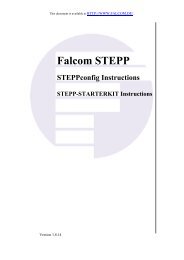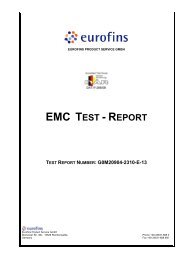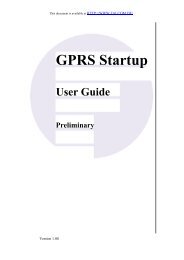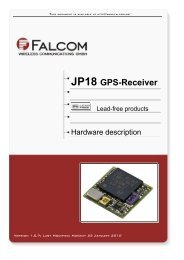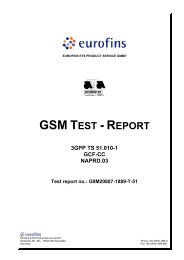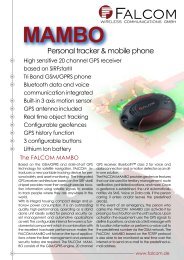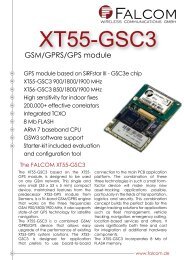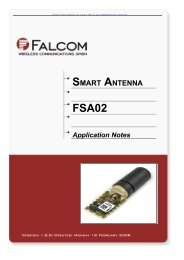JP14-R/Q hardware manual - Falcom
JP14-R/Q hardware manual - Falcom
JP14-R/Q hardware manual - Falcom
Create successful ePaper yourself
Turn your PDF publications into a flip-book with our unique Google optimized e-Paper software.
THIS DOCUMENT IS AVAILABLE AT HTTP://WWW.FALCOM.DE/<br />
<strong>JP14</strong>-R / <strong>JP14</strong>-Q<br />
GPS-Receivers<br />
Version 1.0.5; Updated: 25/09/2007<br />
Lead-free products<br />
Hardware description
<strong>JP14</strong>-R /<strong>JP14</strong>-Q FALCOM GPS RECEIVERS VERSION 1.0.5<br />
Table Of Contents<br />
1 INTRODUCTION ........................................................................6<br />
1.1 General ................................................................................................................6<br />
1.2 Used abbreviations ..............................................................................................7<br />
1.3 Related documents ..............................................................................................8<br />
2 SECURITY .................................................................................9<br />
2.1 General information ..............................................................................................9<br />
2.2 Restricted use ......................................................................................................9<br />
2.3 Children ................................................................................................................9<br />
2.4 Operation/antenna ...............................................................................................9<br />
2.5 Electrostatic Discharge (ESD) ..............................................................................9<br />
3 SAFETY STANDARDS ............................................................10<br />
4 TECHNICAL DATA ..................................................................11<br />
4.1 FEATURES ........................................................................................................11<br />
5 TECHNICAL DESCRIPTION ...................................................12<br />
5.1 Receiver Architecture .........................................................................................12<br />
5.2 Product applications ...........................................................................................13<br />
5.3 Technical specifications .....................................................................................13<br />
5.3.1 Electrical Characteristics ...............................................................................................13<br />
5.3.1.1 General .........................................................................................................................................13<br />
5.3.1.2 Accuracy .......................................................................................................................................13<br />
5.3.1.3 DGPS Accuracy ............................................................................................................................13<br />
5.3.1.4 Datum ...........................................................................................................................................13<br />
5.3.1.5 Time to First Position ....................................................................................................................13<br />
5.3.1.6 Sensitivity * ...................................................................................................................................14<br />
5.3.1.7 Dynamic Conditions .....................................................................................................................14<br />
5.3.1.8 DC Power .....................................................................................................................................14<br />
5.3.1.9 Serial Port .....................................................................................................................................14<br />
5.3.1.10 Time – 1PPS Pulse ....................................................................................................................14<br />
5.4 Power management modes overview ...............................................................15<br />
5.4.1 Normal Operation mode ...............................................................................................15<br />
5.4.2 Adaptive TricklePower mode (ATP) ...............................................................................15<br />
5.4.3 Push-to-Fix Mode .........................................................................................................16<br />
5.4.4 NMEA input message for ATP & PTF Mode ..................................................................17<br />
6 HARDWARE INTERFACE AND CONFIGURATION SIGNALS<br />
.................................................................................................19<br />
6.1 Interfaces (balls assignment) of the <strong>JP14</strong>-R .......................................................19<br />
6.2 Interfaces (balls assignment) of the <strong>JP14</strong>-Q ......................................................20<br />
6.3 Configuration and timing signals ........................................................................21<br />
6.4 Serial communication signals .............................................................................21<br />
6.5 DC input signals .................................................................................................22<br />
7 SOFTWARE INTERFACE .......................................................23<br />
This confidential document is the property of FALCOM and may not be copied or circulated without permission.<br />
Page 2
<strong>JP14</strong>-R /<strong>JP14</strong>-Q FALCOM GPS RECEIVERS VERSION 1.0.5<br />
7.1 SiRF binary data message .................................................................................23<br />
7.2 NMEA data message .........................................................................................24<br />
7.2.1 NMEA output messages ................................................................................................24<br />
7.2.2 NMEA input messages ..................................................................................................24<br />
7.2.3 Transport Message ........................................................................................................25<br />
8 MECHANICAL DRAW .............................................................26<br />
9 LAYOUT RECOMMENDATION ...............................................29<br />
9.1 Ground planes ....................................................................................................29<br />
9.2 RF connection ....................................................................................................29<br />
9.3 Soldering profile .................................................................................................30<br />
10 FIRST STEPS TO MAKE IT WORK ......................................31<br />
11 APPENDIX .............................................................................33<br />
11.1 How to set the target GPS receiver into power saving modes? ........................33<br />
This confidential document is the property of FALCOM and may not be copied or circulated without permission.<br />
Page 3
<strong>JP14</strong>-R /<strong>JP14</strong>-Q FALCOM GPS RECEIVERS VERSION 1.0.5<br />
Version history:<br />
Version Author Changes Release date<br />
1.0.0 F. Beqiri Initial version 26/07/2005<br />
1.0.1 F. Beqiri<br />
1.0.2 F. Beqiri<br />
1.0.3 F. Beqiri<br />
1.0.4 F. Beqiri<br />
- The <strong>JP14</strong>-Q is a 40-pin BGS package (instead of 36-pin BGA package on the early<br />
version). Due to this reason, the following figures and tables are updated (figures 2, 3<br />
and 4 attached; Table 2 – balls 37, 38, 39 and 40 added).<br />
- Table 1 updated (<strong>JP14</strong>-R - balls 13, 14, 15 and 17 changed from GND to NC – not<br />
connected).<br />
- The diagram of the reflow soldering conditions added.<br />
- Corrected round ball diameter from 0.6 mm to 1 mm (see figures 6 and 7).<br />
- Corrected sensitivity of the <strong>JP14</strong> GPS receivers (see chapter 5.3.1.6, page 14).<br />
- Chapter 5.4 on page 15 added. The description of Adaptive TricklePower (ATP) and<br />
Push-to-Fix (PTF) mode is now available.<br />
- The new <strong>JP14</strong>-Q-REV05B PCB and <strong>JP14</strong>-R-REV04B PCB revisions are now available.<br />
The following features have been added:<br />
- test points (the figures throughout this document have been repleaced)<br />
- the Vbat signal incorporates voltage detection.<br />
- reset circuitry has been optimized. It monitors now the VCC signal instead of the<br />
VCCGSP signal and allows the implementation of the Push-to-Fix mode (hibernate<br />
state).<br />
- Corrected size of the <strong>JP14</strong>-Q (height). See chapter 4.1 page 11.<br />
- Updated figures 4,5, and 6 – see chapter 8 page 26.<br />
- Updated average power consumption to 62 mA @ 3.3 (continuous mode). See chapter<br />
5.3.1.8 page 14.<br />
- Corrected 1PPP Pulse duration from 100 ms to 1.5 µs. See chapter 5.3.1.10 page - 14.<br />
- GPS operating firmware currently does not support DGPS.<br />
- Added chapter Appendix “how to set the target device into power saving modes”. See<br />
chapter 5.3.1.10 page 14.<br />
- The description of the pin 18 on <strong>JP14</strong>-R receiver changed from analogue ground to digital<br />
ground.<br />
- Updated soldering profile – see Figure 11, page 30 and read the note below.<br />
12/10/2005<br />
09/01/2006<br />
27/06/2006<br />
02/03/2007<br />
1.0.5 F. Beqiri - <strong>JP14</strong> modules can accept only one reflow process. 25/09/2007<br />
This confidential document is the property of FALCOM and may not be copied or circulated without permission.<br />
Page 4
<strong>JP14</strong>-R /<strong>JP14</strong>-Q FALCOM GPS RECEIVERS VERSION 1.0.5<br />
Cautions<br />
Information furnished herein by FALCOM is believed to be accurate and reliable.<br />
However, no responsibility is assumed for its use. Also the information contained<br />
herein is subject to change without notice.<br />
Please, read carefully the safety precautions.<br />
If you have any technical questions regarding this document or the product described in it,<br />
please, contact your vendor.<br />
General information about FALCOM and its range of products is available at the following<br />
Internet address: http://www.falcom.de/<br />
Trademarks<br />
Some mentioned products are registered trademarks of their respective companies.<br />
Copyright<br />
The <strong>JP14</strong>-R/Q <strong>hardware</strong> description is copyrighted by FALCOM WIRELESS<br />
COMMUNICATIONS GmbH with all rights reserved. No part of this document may<br />
be produced in any form without the prior written permission of FALCOM<br />
WIRELESS COMMUNICATIONS GmbH.<br />
FALCOM WIRELESS COMMUNICATIONS GmbH.<br />
No patent liability is assumed with respect to the use of the information contained herein.<br />
This confidential document is the property of FALCOM and may not be copied or circulated without permission.<br />
Page 5
<strong>JP14</strong>-R /<strong>JP14</strong>-Q FALCOM GPS RECEIVERS VERSION 1.0.5<br />
1 INTRODUCTION<br />
1.1 General<br />
This description is focussed on the GPS receivers of the FALCOM <strong>JP14</strong>-R and <strong>JP14</strong>-Q<br />
from FALCOM GmbH.<br />
<strong>JP14</strong>-R/Q a new of highly integrated, low-power GPS products – based on a 0.13<br />
micron CMOS process of the SiRFstarIII - GSC3f – architecture are single-board<br />
solutions with increased to 20 parallel channel receiver. Both units the <strong>JP14</strong>-R and<br />
<strong>JP14</strong>-Q for the first time combine a complete A-GPS digital baseband processor, RF<br />
front end and 4 megabits of flash memory in a single 10 mm x 24 mm package,<br />
providing manufacturers of cell phones, PDAs and other portable and wireless<br />
devices with a drop-in AGPS solution they can use to deliver real-time location and<br />
navigation capabilities in a simpler, smaller design with extended battery life.<br />
Each unit in a single package will deliver exceptional sensitivity, low power<br />
consumption and extremely fast time to first fix (TTFF) in a compact, 40-pin BGA<br />
packages. The digital section of both GPS receivers includes a powerful SiRFstarIII<br />
core GPS signal processor that handles all the time critical and low latency<br />
acquisition, tracking and reacquisition tasks autonomously, and a 50-MHz ARM7TDMI<br />
processor. The <strong>JP14</strong>-R/Q with the equivalent of more than 200,000 correlators used<br />
for processing signals, enable extremely fast and deep GPS signal search<br />
capabilities; achieving time-to-first-fix in only seconds; resulting a significant<br />
improvement on the GPS performance. They come with an integrated 4-megabit<br />
flash memory, and 1-megabit SRAM memory eliminating the need for an external<br />
flash component and significantly simplifying the routing associated with integrating<br />
a GPS receiver into a board design. Supporting multiple reference frequencies, the<br />
RF section of the <strong>JP14</strong>-R/Q is the most highly integrated, lowest-power SiRF RF<br />
implementation to date, combining RTC and monitor circuitry and is designed to<br />
bring many components that were previously on the board into the silicon while<br />
reducing RF current consumption to just 13 mA.<br />
Each of units delivers major advancements in GPS performance, accuracy,<br />
integration, computing power and flexibility. The unit has an integrated temperature<br />
compensated crystal oscillator (TCXO). Due to the higher stability of frequency it<br />
offers a high-improved GPS performance. In addition, higher sensitivity allows it more<br />
flexibility on its design, the placement of the antenna and the selection of the kind of<br />
antenna. The GPS receiver continuously tracks all satellites in view, thus providing<br />
accurate satellite position data. The physical interface to the unit application is<br />
made through provided balls. This is required for controlling the unit, receiving GPS<br />
location data, transferring data and providing power supply line. The <strong>JP14</strong>-R/Q units<br />
incorporate 4 megabits of flash memory required for storing the GPS software and<br />
user application programs and 1 megabit of static RAM.<br />
Compared to the <strong>JP14</strong>-S, the <strong>JP14</strong>-R is more optimized for location applications<br />
requiring high performance in a very smaller form factor – just 10 x 24 mm package,<br />
ideal for devices with limited onboard processing power. While the <strong>JP14</strong>-Q comes<br />
more smaller than <strong>JP14</strong>-R, just 15 x 17 mm package.<br />
The <strong>JP14</strong>-R/Q concept builds perfect basis for the design of high-sensitive, lowpower,<br />
compact and cost efficient state-of-the-art GPS enabled system solutions for<br />
target platforms such as mobile phones, automotive systems, portable computing<br />
devices, and embedded consumer devices. The FALCOM <strong>JP14</strong>-R and <strong>JP14</strong>-Q are<br />
also designed to be entire products such as AVL tracking unit, handheld GPS.<br />
The core of the <strong>JP14</strong>-R and <strong>JP14</strong>-Q units is comprised of the GSC3f that comes with<br />
Digital and RF in a single chip, and the GSW3 software stored into the on-chip 4megabit<br />
FLASH that is API compatible with previous GSW2 software.<br />
This confidential document is the property of FALCOM and may not be copied or circulated without permission.<br />
Page 6
<strong>JP14</strong>-R /<strong>JP14</strong>-Q FALCOM GPS RECEIVERS VERSION 1.0.5<br />
The internal GSW3 software completes the package providing flexible system<br />
architecture for standalone GPS based products.<br />
Please, consult SiRF (www.sirf.com) for special information about the GSC3f SiRFstarIII<br />
chipset.<br />
Figure 1: The FALCOM <strong>JP14</strong>-R GPS receiver (top and bottom view)<br />
Figure 2: The FALCOM<strong>JP14</strong>-Q GPS receiver (top and bottom view)<br />
Users are advised to proceed quickly to the chapter "Security" and read the hints<br />
carefully to secure its optimal use.<br />
1.2 Used abbreviations<br />
Abbreviation Description<br />
A-GPS Assisted - Global Positioning System<br />
BGA Ball Grid Array<br />
DGPS Differential GPS<br />
DOP Dilution of Precision<br />
GPS Global Positioning System<br />
GGA GPS Fixed Data<br />
LNA Low Noise Amplifier<br />
This confidential document is the property of FALCOM and may not be copied or circulated without permission.<br />
Page 7
<strong>JP14</strong>-R /<strong>JP14</strong>-Q FALCOM GPS RECEIVERS VERSION 1.0.5<br />
Abbreviation Description<br />
NMEA National Maritime Electronics Association<br />
PRN Pseudo - Random Noise Number – The Identity of GPS satellites<br />
RF Radio Frequency<br />
RP Receive Protocol<br />
RTC Real Time Clock<br />
RTCM Radio Technical Commission for Maritime Services<br />
SDI Data input<br />
SDO Data output<br />
SA Selective Availability<br />
WAAS Wide Area Augmentation System<br />
MSK Minimum Shift Keying<br />
PCB Printed Circuit Board<br />
PRN Pseudo-random noise<br />
IF Intermediate Frequency<br />
A/D Analog/Digital<br />
1.3 Related documents<br />
[1.] SiRF binary and NMEA protocol specification;<br />
www.falcom.de│Support│Download│Documentation│Sirf│ SiRFmessages_SSIII.zip<br />
[2.] SiRF-demo software and <strong>manual</strong>;<br />
www.falcom.de│Support│Download│Documentation│Sirf│ SiRFdemo.pdf<br />
www.falcom.de│Support│Download│Software & Tools│Sirf│ SiRFdemo.zip<br />
This confidential document is the property of FALCOM and may not be copied or circulated without permission.<br />
Page 8
<strong>JP14</strong>-R /<strong>JP14</strong>-Q FALCOM GPS RECEIVERS VERSION 1.0.5<br />
2 SECURITY<br />
This chapter contains important information for the safe and reliable use of the GPS<br />
receiver. Please, read this chapter carefully before starting to use the GPS receiver.<br />
2.1 General information<br />
The Global Positioning System uses satellite navigation, an entirely new concept in<br />
navigation. GPS has become established in many areas, for example, in civil aviation<br />
or deep-sea shipping. It is making deep inroads in vehicle manufacturing and before<br />
long everyone of us will use it this way or another.<br />
The GPS system is operated by the government of the United States of America,<br />
which also has sole responsibility for the accuracy and maintenance of the system.<br />
The system is constantly being improved and may entail modifications effecting the<br />
accuracy and performance of the GPS equipment.<br />
2.2 Restricted use<br />
Certain restrictions on the use of the GPS receiver may have to be observed on<br />
board a plane, in hospitals, public places or government institutions, laboratories etc.<br />
Follow these instructions.<br />
2.3 Children<br />
Do not allow children to play with the GPS receiver. It is not a toy and children could<br />
hurt themselves or others. The GPS receiver consists of many small parts which can<br />
come loose and could be swallowed by small children. Thoughtless handling can<br />
damage the GPS receiver.<br />
2.4 Operation/antenna<br />
Operate the GPS receiver with an antenna connected to it and with no obstruction<br />
between the receiver and the satellite.<br />
Make absolutely sure that the antenna socket or antenna cable is not shorted as this<br />
would render the GPS receiver disfunctional.<br />
Do not use the receiver with a damaged antenna. Replace a damaged antenna<br />
without delay. Use only a manufacturer-approved antenna. Use only the supplied or<br />
an approved antenna with your GPS receiver. Antennas from other manufacturers<br />
which are not authorized by the supplier can damage the GPS receiver.<br />
Technical modifications and additions may contravene local radio-frequency<br />
emission regulations or invalidate the type approval.<br />
Authorized GPS antennas: FAL-ANT-3 (active antenna)<br />
2.5 Electrostatic Discharge (ESD)<br />
The <strong>JP14</strong>-R/Q GPS receivers contain class 1 devices. The following Electrostatic<br />
Discharge (ESD) precautions are recommended:<br />
- Protective outer garments.<br />
- Handle device in ESD safeguarded work area.<br />
- Transport device in ESD shielded containers.<br />
- Monitor and test all ESD protection equipment.<br />
- Treat the <strong>JP14</strong>-R/Q GPS receivers as extremely sensitive to ESD.<br />
This confidential document is the property of FALCOM and may not be copied or circulated without permission.<br />
Page 9
<strong>JP14</strong>-R /<strong>JP14</strong>-Q FALCOM GPS RECEIVERS VERSION 1.0.5<br />
3 SAFETY STANDARDS<br />
The GPS receiver meets the safety standards for RF receivers and the standards and<br />
recommendations for the protection of public exposure to RF electromagnetic<br />
energy established by government bodies and professional organizations, such as<br />
directives of the European Community, Directorate General V in matters of radio<br />
frequency electromagnetic energy.<br />
This confidential document is the property of FALCOM and may not be copied or circulated without permission.<br />
Page 10
<strong>JP14</strong>-R /<strong>JP14</strong>-Q FALCOM GPS RECEIVERS VERSION 1.0.5<br />
4 TECHNICAL DATA<br />
4.1 FEATURES<br />
- OEM single board 20 channel GPS receiver<br />
- Size: <strong>JP14</strong>-R: 10.2 x 24.5 x 3 mm (B x L x H)<br />
<strong>JP14</strong>-Q: 15.7 x 17.3 x 3 mm (B x L x H)<br />
- Weight: <strong>JP14</strong>-R: 1.5 g (without shielding)<br />
- Casing: Fully shielded<br />
- TCXO: ± 0.5 ppm<br />
<strong>JP14</strong>-Q: 1.2 g (without shielding)<br />
- FLASH Memory: on-chip 4 Mbit FLASH and 1 Mbit SRAM.<br />
- Operating voltage: +3.3 V DC ±5 %<br />
- Power consumption: 240 mW (continuous mode)<br />
- Power management: Adaptive TricklePower (ATP)*<br />
Push-to-Fix (PTF)*<br />
* For more details see chapter 5.4.<br />
- Temperature range: -40 to +85 °C (operation, transportation and<br />
storage).<br />
- Protocol: SDI1/ SDO1**<br />
:<br />
NMEA 38400 baud, Msg.: GLL, GGA, RMC, GSV,<br />
GSA, VTG<br />
8 data bits, no parity, 1 stop bit<br />
** All options related to this serial port are available<br />
upon request.<br />
This confidential document is the property of FALCOM and may not be copied or circulated without permission.<br />
Page 11
<strong>JP14</strong>-R /<strong>JP14</strong>-Q FALCOM GPS RECEIVERS VERSION 1.0.5<br />
5 TECHNICAL DESCRIPTION<br />
5.1 Receiver Architecture<br />
The <strong>JP14</strong>-R/Q OEM GPS receivers from FALCOM are new OEM GPS receiver products<br />
that feature the SiRFstarIII single chipset. The core of <strong>JP14</strong>-R/Q units is comprised of<br />
the GSC3 that includes the Digital and RF in a single chip. The <strong>JP14</strong>-R/Q are built<br />
around re-configurable high-output segmented matched filter in conjunction with a<br />
FFT processor, which can search all 1023 chips of the GPS code simultaneously over<br />
a wide frequency range for fast initial acquisition with large uncertainties. The<br />
flexibility of the core allows the core processing engine and memory to be<br />
reconfigured to track more than 20 satellites using the same <strong>hardware</strong>. This flexibility<br />
make the <strong>JP14</strong>-R/Q highly efficient engines for wide variety of location applications.<br />
The core of <strong>JP14</strong>-R/Q contains a built in sequencer, which handles all the high-rate<br />
interrupts for GPS and SBAS (WAAS, EGNOS) tracking and acquisitions. After<br />
initialization, the receiver handles all the time critical and low latency acquisition,<br />
tracking and reacquisition tasks of GPS and SBAS autonomously. The on-chip SRAM<br />
size is 1-Mbit (32Kx32) memory that can be used for either instructions or data. The<br />
SRAM is designed for a combination of low power and high speed, and can support<br />
single cycle reads for all bus speeds. In many applications, the 4 Mbit FLASH<br />
completely eliminates the need for external data memory.<br />
Figure 3: Architecture of the <strong>JP14</strong>-R/Q GPS receivers.<br />
Figure 3 above shows the block diagram of the <strong>JP14</strong>-R/Q architecture.<br />
This confidential document is the property of FALCOM and may not be copied or circulated without permission.<br />
Page 12
<strong>JP14</strong>-R /<strong>JP14</strong>-Q FALCOM GPS RECEIVERS VERSION 1.0.5<br />
5.2 Product applications<br />
- Handheld GPS receiver applications<br />
- Automotive applications<br />
- Marine navigation applications<br />
- Aviation applications<br />
- Timing applications<br />
5.3 Technical specifications<br />
5.3.1 Electrical Characteristics<br />
5.3.1.1 General<br />
Frequency L1, 1575.42 MHz<br />
C/A code 1.023 MHz chip rate<br />
Channels 20<br />
Max. update rate 1 Hz<br />
Processor speed 6, 12.5, 25 and 49 MHz<br />
Data bus 16 bit<br />
5.3.1.2 Accuracy<br />
Position Autonomous: 10 meters CEP without SA<br />
SBAS: < 5 meter<br />
Velocity 0.1 meters/second, without SA<br />
Time 1 microsecond synchronized to GPS time<br />
5.3.1.3 DGPS Accuracy<br />
Position 1 to 5 meters, typical<br />
Velocity 0.05 meters/second, typical<br />
5.3.1.4 Datum<br />
WGS-84<br />
5.3.1.5 Time to First Position<br />
GSM < 20 sec., average<br />
3G < 20 sec., average<br />
CDMA < 16 sec., average<br />
Hot start < 18 sec., average<br />
Hot start (open sky) < 1 sec., average<br />
Cold start < 42 sec., average<br />
This confidential document is the property of FALCOM and may not be copied or circulated without permission.<br />
Page 13
<strong>JP14</strong>-R /<strong>JP14</strong>-Q FALCOM GPS RECEIVERS VERSION 1.0.5<br />
5.3.1.6 Sensitivity *<br />
GSM 15 dBHz**<br />
3G 15 dBHz**<br />
CDMA 15 dBHz**<br />
Tracking 13 dBHz<br />
Hot Start 15 dBHz<br />
Cold Start 30 dBHz<br />
* The sensitivity value is specified at the correlator. On a <strong>JP14</strong> Receivers using GSW3 firmware<br />
with the supplied antenna, 17 dBHz is equivalent to -155 dBm. Other board and antenna<br />
characteristics will vary.<br />
** With SiRFLock firmware.<br />
5.3.1.7 Dynamic Conditions<br />
Altitude 18,000 meters (60,000 feet) max.<br />
Velocity
<strong>JP14</strong>-R /<strong>JP14</strong>-Q FALCOM GPS RECEIVERS VERSION 1.0.5<br />
5.4 Power management modes overview<br />
There are three basic operating modes in which the <strong>JP14</strong> family operates during use.<br />
Each mode is used to accomplish a different task during the process of acquiring<br />
and maintaining the GPS information. The <strong>JP14</strong> family include all the functionality<br />
necessary to implement the three different modes of operation. By default, the <strong>JP14</strong><br />
family runs in normal mode (continuous mode). All three different operating modes<br />
are described below. Additionally, two of them such as Adaptive TricklePower<br />
(ATP) and Push-to-Fix (PTF) are designed as power saving modes.<br />
This chapter describes the power management considerations of <strong>JP14</strong> family based<br />
on the <strong>JP14</strong>_REV04A PCB version.<br />
5.4.1 Normal Operation mode<br />
In this default implementation of normal mode the <strong>JP14</strong> family is fully powered and<br />
performs the function of signal search, acquisition, measurement and satellite<br />
tracking. The amount of time spent in the initial full power is dependent on the start<br />
conditions such as the number of satellites for which the ephemeris data must be<br />
collected and the time to calibrate the RTC. When the JP3 family has been lockedon<br />
to at least four satellites, the receiver is able to calculate its current positions. In<br />
this mode the <strong>JP14</strong> family is fully powered and satellite searching, initial acquisition,<br />
initial position calculation and tracking measurement functions are always<br />
performed. In order to reduce the start up time of the receiver it is preferable to<br />
connect externally a backup battery, so that the RTC is running during the power<br />
interrupt. The backup power is required for retention of SRAM memory and<br />
maintaining the Real-Time-Clock. The validity of data stored in SRAM is kept due to<br />
RTC keeps running and these data will be needed on the next power up scenario.<br />
5.4.2 Adaptive TricklePower mode (ATP)<br />
Adaptive TricklePower (ATP) is a variant of TricklePower . But only ATP and Push-To-<br />
Fix (PTF is described in next chapter) modes are supported on <strong>JP14</strong> family. ATP is best<br />
suited for applications where regular updates are required, and where stronger<br />
signal levels are expected. The transition of receiver into the ATP mode can be done<br />
and configured by using either the Action│Set Low Power (Trickle Power) …<br />
command available in SiRFDemo evaluation software or the input command<br />
described in chapter 5.4.4 on page 17.<br />
When ATP is enabled the receiver will maximize the navigation performance.<br />
Depending on different states of the power management circuits, the receiver<br />
belongs to one of three system states:<br />
Full Power State (Acquisition/Tracking modes)<br />
After initial turn on or system reset, the <strong>JP14</strong> will remain in the full power state until<br />
a series of Kalman filter navigation solution is obtained, all ephemeris data is<br />
collected and the RTC is calibrated before transitioning to CPU-state. The receiver<br />
stays in full power state until a position solution is made and estimated to be<br />
reliable. In this state all RF circuitry and the baseband are fully powered. Even in<br />
this state, there is a difference in power consumption during acquisition mode<br />
and tracking mode. During the acquisition mode, processing is more intense, thus<br />
consuming more power (Diagram is shown below that is simplified for ease of<br />
understanding. Timing values are only examples).<br />
CPU-State<br />
In this state the LNA in the RF section is shut off. The TCXO and fractional<br />
synthesizer from the RF section are still powered in order to provide a clock to the<br />
This confidential document is the property of FALCOM and may not be copied or circulated without permission.<br />
Page 15
<strong>JP14</strong>-R /<strong>JP14</strong>-Q FALCOM GPS RECEIVERS VERSION 1.0.5<br />
CPU. This state is entered when the satellite measurements have been collected<br />
but the navigation solution still needs to be computed, thus consuming power is<br />
less than in the full power state.<br />
Standby state<br />
In the standby state, power remains applied to the <strong>JP14</strong> family, but the RF section<br />
is completely powered off and the clock to the baseband is stopped. About 600<br />
µA of current is drawn in this state for the internal core regulator, RTC and batterybacked<br />
RAM. The receiver enters this state when a position fix has been<br />
computed and reported. Typically, before shutting down the RTC wakeup register<br />
is programmed to wake up the system sometime in the future.<br />
Remark: The environment temperature may also affect the power consumption in the Standby state.<br />
Figure 4: Three system states into the ATP mode.<br />
The transition from Standby state back to the full power is generated through the<br />
internal RTC, which transmits a wake up signal to the GPS engine to switch it on. The<br />
<strong>JP14</strong> is woken up and begins to acquire the on view satellites and to collect their<br />
data. Under normal tracking conditions, the receiver is set for a specific update<br />
period (range from 1 to 10 seconds), and a specific sampling time during each<br />
period (range from 200 to 900 ms). The receiver turns to full power state for the<br />
sampling time to collect data, and then operates in Standby state for the remainder<br />
of the update period. The next full-power state is initiated by an RTC wakeup. But in<br />
harsh tracking environments the receiver automatically switches to full power state<br />
to improve navigation performance. When the satellites are sorted according their<br />
signal strength, the fourth satellite determines if the transition will occur or not. The<br />
threshold is 26 dB-Hz. When tracking, conditions return to normal (four or more<br />
satellites with C/No of 30 dB-Hz or higher), the receiver switches back to the power<br />
saving mode.<br />
5.4.3 Push-to-Fix Mode<br />
The Push-to-Fix mode puts the FALCOM <strong>JP14</strong> family into a background duty cycle<br />
which provides a periodic refresh of position, receiver time, ephemeris data and RTC<br />
calibration every 10 seconds to 2 hours. The transition of receiver into the Push-to-Fix<br />
mode can be implemented and configured by using either the Action│Set Low<br />
Power (Trickle Power) … command available in SiRFDemo evaluation software or<br />
the input command described in chapter 5.4.4 on page 17.<br />
This confidential document is the property of FALCOM and may not be copied or circulated without permission.<br />
Page 16
<strong>JP14</strong>-R /<strong>JP14</strong>-Q FALCOM GPS RECEIVERS VERSION 1.0.5<br />
The PTF period is 30 minutes by default but can be anywhere between 10 seconds<br />
and 2 hours. When the PTF mode is enabled, due to a new PTF cycle, the receiver<br />
will stay on full power until the good navigation solution is computed. The so-called<br />
hibernate state will follow for the remainder of the period. For example, if the<br />
receiver took 15 seconds to fix position and refresh ephemeris on the default period<br />
of 30 minutes, the receiver will sleep for the 29 minutes and 45 seconds. Whenever<br />
the receiver wakes up, it collects almanac and ephemeris data and then goes back<br />
to the previous sleep phase again.<br />
* To Be Defined<br />
Remark: The environment temperature may also affect the power consumption in the Hibernate state.<br />
Figure 5: Three system states in the PTF mode.<br />
5.4.4 NMEA input message for ATP & PTF Mode<br />
Power saving mode is disabled by default. In order to enable it, input the NMEA<br />
message in table below. The description of each parameter used for Adaptive<br />
TricklePower or Push-to-Fix is listed below. How to send these messages to the<br />
target unit, refer to chapter Appendix section 11.1 page 33.<br />
Syntax $PSRF107,,,,,,<br />
Examples<br />
$PSRF107,1,400,2000,60000,60000,1*17<br />
$PSRF107,2,400,60000,60000,60000,0*21<br />
$PSRF107,0,0,0,0,0,0*21<br />
Parameter Description<br />
<br />
It defines the mode to be performed. It can be set to:<br />
0 Sets the target receiver back to the Continuous mode<br />
(full power).<br />
1 Sets the target receiver into the Adaptive TricklePower<br />
(TP) mode.<br />
2 Sets the target receiver into the Push-To-Fix (PTF) mode.<br />
<br />
It defines the OnTime period in milliseconds the receiver will stay in full<br />
power state until a position solution is made and estimated to be<br />
This confidential document is the property of FALCOM and may not be copied or circulated without permission.<br />
Page 17
<strong>JP14</strong>-R /<strong>JP14</strong>-Q FALCOM GPS RECEIVERS VERSION 1.0.5<br />
reliable. Please note that, in harsh tracking environments the receiver<br />
automatically switches to full power state to improve navigation<br />
performance even if the defined OnTime has been expired. When the<br />
satellites are sorted according their signal strength, the fourth satellite<br />
determines if the transition to Standby mode/hibernate state will occur<br />
or not. It can be set to a value between:<br />
200 ... 900 OnTime period in milliseconds<br />
<br />
It defines the complete interval of time in milliseconds the receiver will<br />
stay in full power and Standby mode/hibernate state.<br />
It can be set to a value between:<br />
1000 ... 10000 The interval of time in milliseconds for Adaptive<br />
TricklePower (ATP) mode.<br />
10000 ... 7200000 The interval of time in milliseconds for Push-To-Fix<br />
(PTF) mode.<br />
<br />
It specifies the Maximum Acquire Time in milliseconds how long the<br />
target receiver should attempt to acquire satellites and navigate. If this<br />
time elapses and no GPS-fix is obtained, the target receiver is set into<br />
the sleep mode for up to MaxOffTime in ms. It means, the target receiver<br />
searches for MaxAcqTime in ms, sleeps for MaxOffTime in ms, searches<br />
again for MaxAcqTime in ms, etc. It can be set to a value between:<br />
1000 ... No Limit<br />
<br />
It specifies the Maximum Off Time in milliseconds how long the target<br />
receiver should remain off (sleep mode) before making another<br />
attempt to navigate. This mode is enabled, if the target receiver is<br />
turned on and acquires satellites, but does not navigate. This mode is<br />
disabled, if the target receiver is turned on, acquires and navigates. It<br />
can be set to a value between:<br />
1000 .. 1800000<br />
<br />
<br />
It enables/disables the Adaptive TricklePower (ATP) mode if the value of<br />
the parameter is set to 1, otherwise it does not have any effect.<br />
It can be set to:<br />
0 It disables the Adaptive TricklePower (ATP) mode.<br />
1 It enables the Adaptive TricklePower (ATP) mode.<br />
CHECKSUM is a two-hex character as defined in the NMEA specification.<br />
Use of checksums is required on all input messages. For more detailed<br />
information, refer to the chapter 7.2.3 page 25.<br />
<br />
* Note:<br />
Each message is terminated using Carriage Return (CR) Line Feed (LF)<br />
which is hex 0D 0A. Because 0D 0A are not printable ASCII characters,<br />
they are omitted from the example strings, but must be sent to terminate<br />
the message and cause the receiver to process that input message.<br />
• SiRF recommends the use of 300 ms, 1-second or 400 ms, 2-second for<br />
optimum performance.<br />
This confidential document is the property of FALCOM and may not be copied or circulated without permission.<br />
Page 18
<strong>JP14</strong>-R /<strong>JP14</strong>-Q FALCOM GPS RECEIVERS VERSION 1.0.5<br />
6 HARDWARE INTERFACE AND CONFIGURATION<br />
SIGNALS<br />
6.1 Interfaces (balls assignment) of the <strong>JP14</strong>-R<br />
Ball Name I/O Description Level<br />
1 VCC I Main power supply + 3.3 V DC ±5 %<br />
2 VCC<br />
3 VBAT I Power for RTC and SRAM +3 V DC ±5%<br />
4 VDDK O Core power at 1.5 V. Do not use, leave it open.<br />
5 SDI1 I Serial Data Input A CMOS<br />
6 SDO1 O Serial Data Output A CMOS<br />
7 SDO2 O Serial Data Output B (It is not supported by default GSW3.1.0) CMOS<br />
8 SDI2 I Serial Data Input B (It is not supported by default GSW3.1.0) CMOS<br />
9 NADC_D I Do not use, leave it open.<br />
10 SPI_EN I Control-line for production test. Do not use, leave it open. CMOS<br />
11 SPI_CLK I Control-lines for production test. Do not use, leave it open.<br />
12 SPI_DATA O Control-line for production test. Do not use, leave it open.<br />
13 NC<br />
14 NC - Not connected -<br />
15 NC<br />
16 GPIO0 I/O General propose input/output CMOS<br />
17 NC - Not connected -<br />
18 GND Digital ground 0 V<br />
19 GND_RF Analogue ground<br />
20 VANT I Power supply for an active antenna<br />
Up to +12 V DC / max. 25<br />
mA<br />
21 RF_IN I GPS signal from connected antenna 50 Ohms @ 1.575 GHz<br />
22 GND_RF Analogue grounds<br />
23 GND_RF<br />
24 VCCRF O Supply voltage of RF section + 2.85 V DC / max. 25 mA<br />
25 GND Digital grounds 0 V<br />
26 GND<br />
27 NSRESET I Do not use, leave it open.<br />
28 T-MARK O 1 PPS Time Mark Output CMOS<br />
29 BOOTSEL I Boots the unit into the Update mode, if it is set to HIGH. CMOS (=VCC)<br />
30 NADC_CS O Control outputs. Do not use, leave it open. CMOS<br />
31 TIMERSYNC O Control outputs. Do not use, leave it open. CMOS<br />
32 CS2 O Control outputs. Do not use, leave it open. CMOS<br />
33 GPIO1 I/O General propose input/output CMOS<br />
34 VCCGSP3 O<br />
Control output for baseband processor. Do not use, leave it<br />
open.<br />
CMOS<br />
This confidential document is the property of FALCOM and may not be copied or circulated without permission.<br />
Page 19
<strong>JP14</strong>-R /<strong>JP14</strong>-Q FALCOM GPS RECEIVERS VERSION 1.0.5<br />
Ball Name I/O Description Level<br />
35 PWRCTL O Control outputs. Do not use, leave it open. CMOS<br />
36 WAKEUP O Control outputs. Do not use, leave it open. CMOS<br />
37 GPIO10 I/O General propose input/output CMOS<br />
38 M-RST I Rest the unit, active low CMOS<br />
39 VDD_RTC I Control-line for production test. Do not use, leave it open. +1.5 V DC<br />
40 ON/OFF I Control-line for production test. Do not use, leave it open. CMOS<br />
Table 1: Pin assignment of the <strong>JP14</strong>-R<br />
6.2 Interfaces (balls assignment) of the <strong>JP14</strong>-Q<br />
Ball Name I/O Description Level<br />
1 GND_RF Analogue grounds<br />
2 VANT I Power supply for an active antenna<br />
Up to +12 V DC / max. 25<br />
mA<br />
3 GND Analogue grounds 0 V<br />
4 VCC I Main power supply + 3.3 V DC ±5 %<br />
5 VCC<br />
6 VBAT I Power for RTC and SRAM +3 V DC ±5%<br />
7 VCCRF O Supply voltage of RF section + 2.85 V DC / max. 25 mA<br />
8 M-RST I Rest the unit, active low CMOS<br />
9 VCCGSP3 O<br />
Control output for baseband processor.Do not use, leave<br />
it open.<br />
CMOS<br />
10 PWRCTL O Control outputs. Do not use, leave it open. CMOS<br />
11 BOOTSEL I Boots the unit into the Update mode, if it is set to HIGH. CMOS (=VCC)<br />
12 WAKEUP O Control outputs. Do not use, leave it open. CMOS<br />
13 CS2 O Control outputs. Do not use, leave it open. CMOS<br />
14 GPIO1 I/O General propose input/output CMOS<br />
15 GPIO0 I/O General propose input/output CMOS<br />
16 SDI1 I Serial Data Input A CMOS<br />
17 SDO2<br />
O Serial Data Output B (It is not supported by default<br />
GSW3.1.0)<br />
CMOS<br />
18 SDO1 O Serial Data Output A CMOS<br />
19 VDDK O Core power at 1.5 V. Do not use, leave it open.<br />
20 SDI2<br />
I Serial Data Input B (It is not supported by default<br />
GSW3.1.0)<br />
CMOS<br />
21 GPIO10 I/O General propose input/output CMOS<br />
22 VDD_RTC I Control-line for production test. Do not use, leave it open. +1.5 V DC<br />
23 T-MARK O 1 PPS Time Mark Output CMOS<br />
24 ON/OFF I Control-line for production test. Do not use, leave it open. CMOS<br />
25 NADC_CS O Control outputs. Do not use, leave it open. CMOS<br />
This confidential document is the property of FALCOM and may not be copied or circulated without permission.<br />
Page 20
<strong>JP14</strong>-R /<strong>JP14</strong>-Q FALCOM GPS RECEIVERS VERSION 1.0.5<br />
Ball Name I/O Description Level<br />
26 TIMERSYNC O Control outputs. Do not use, leave it open. CMOS<br />
27 SPI_EN I Control-line for production test. Do not use, leave it open. CMOS<br />
28 SPI_CLK I<br />
Control-lines for production test. Do not use, leave it<br />
open.<br />
29 NADC_D I Do not use, leave it open.<br />
30 SPI_DATA O Control-line for production test. Do not use, leave it open.<br />
31 NSRESET I Do not use, leave it open.<br />
32 GND Digital grounds 0 V<br />
33 GND<br />
34 GND<br />
35 GND_RF Analogue grounds 0 V<br />
36 RF_IN I GPS signal from connected antenna 50 Ohms @ 1.575 GHz<br />
37 NC<br />
38<br />
39<br />
NC<br />
NC<br />
- Not connected -<br />
40 NC<br />
Table 2: Pin assignment of the <strong>JP14</strong>-Q<br />
6.3 Configuration and timing signals<br />
M-RST This pin provides an active-low reset input to the<br />
board. It causes the board to reset and to start<br />
searching for satellites. If not utilized, this input pin may<br />
be left open.<br />
T-MARK This pin provides 1 pulse per second output from the<br />
board, which is synchronized to within 1 microsecond<br />
of GPS time. The output is a CMOS level signal.<br />
BOOTSEL Set this Pin to high (+3.3 V DC) for<br />
reprogramming the flash of the <strong>JP14</strong>-R/Q (for instance<br />
updating a new firmware for the <strong>JP14</strong>-R/Q).sall<br />
6.4 Serial communication signals<br />
The board supports two full duplex serial channels. All serial connections are at<br />
CMOS level. If you need different voltage levels, use appropriate level shifter, (e.g.<br />
MAX 3232 from Maxim) in order to obtain RS232 compatible signal levels (see also<br />
chapter 9). All supported baud rates can be controlled from the appropriate<br />
screens in SiRFdemo software. You can directly communicate with it through a PC<br />
serial port.<br />
SDI1 This is the main receiving channel and is used to<br />
receive software commands to the board from<br />
SiRFdemo software or from user written software.<br />
SDI2 This is the auxiliary receiving channel and is used to<br />
input differential corrections to the board to enable<br />
DGPS navigation. Note that, the current operating<br />
firmware does not support DGPS.<br />
SDO1 This is the main transmitting channel and is used to<br />
output navigation and measurement data to<br />
SiRFdemo or user written software.<br />
SDO2 For user’s application (It is not supported by default<br />
GSW3.1.0).<br />
This confidential document is the property of FALCOM and may not be copied or circulated without permission.<br />
Page 21
<strong>JP14</strong>-R /<strong>JP14</strong>-Q FALCOM GPS RECEIVERS VERSION 1.0.5<br />
6.5 DC input signals<br />
VCC This pin is the main DC power supply for 3,3 V ±5 %<br />
powered boards <strong>JP14</strong>-R/Q.<br />
RF_IN Active antennas have an integrated low-noise<br />
amplifier. They can be directly connected to this pin<br />
(RF_IN). If an active antenna is connected to RF_IN,<br />
the integrated low-noise amplifier of the antenna<br />
needs to be supplied with the correct voltage<br />
through pin VANT.<br />
Caution: Do not connect or disconnect the antenna<br />
while the <strong>JP14</strong>-R and <strong>JP14</strong>-Q are running.<br />
Caution: The RF_IN is always fed from the input<br />
voltage on the VANT. Do not use any input voltage on<br />
the RF_IN pin.<br />
VANT This pin is an input and reserved for an external DC<br />
power supply for an active antenna.<br />
The antenna bias for an external active antenna can<br />
be provided in two ways to pin VANT.<br />
In order to use a 5 V or 12 V active GPS antenna, the<br />
VANT has to be connected to 5 V, 12 V external<br />
power supply, respectively.<br />
The other possibility is available when you connect<br />
the VCCRF output (which provides 2.85 V) to VANT, so<br />
that an antenna with 2.85 V supply voltage can be<br />
used.<br />
Hint: The input voltage on the VANT should be chosen<br />
in according to the antenna to be used.<br />
Note: The GPS receivers <strong>JP14</strong>-R/Q have to be<br />
connected to active GPS antennas with a max. current<br />
25 mA.<br />
VCCRF This pin is an output, which provides +2.85 V DC, and<br />
can be connected to the V_ANT, to supply the<br />
connected GPS antenna (2,85V active antenna).<br />
Note: The maximum output current on this pin should<br />
be limited upto 25 mA to protect the GPS receiver from<br />
damage.<br />
This confidential document is the property of FALCOM and may not be copied or circulated without permission.<br />
Page 22
<strong>JP14</strong>-R /<strong>JP14</strong>-Q FALCOM GPS RECEIVERS VERSION 1.0.5<br />
7 SOFTWARE INTERFACE<br />
The FALCOM <strong>JP14</strong>-R/Q support NMEA-0183 and SiRF binary protocols. A short<br />
description of these protocols is provided herein.<br />
For more detailed information about the messages listed in tables below, please refer<br />
to the SiRFstarIII message set specification available in the section<br />
“Support/Downloads/Documentation/SiRF/SiRFmessages_SSIII.zip” at FALCOM<br />
homepage.<br />
7.1 SiRF binary data message<br />
Table 6 lists the messages for the SiRF output<br />
Hex ASCII Name Description<br />
0 x 02 2 Measured Navigation Data Position, velocity and time<br />
0 x 03 3 True Tracker Data Not implemented<br />
0 x 04 4 Measured Tracking Data Satellite and C/No information<br />
0 x 06 6 SW Version Receiver software<br />
0 x 07 7 Clock Status Current clock status<br />
0 x 08 8 50 BPS Subframe Data Standard ICD format<br />
0 x 09 9 Throughput Navigation complete data<br />
0 x 0A 10 Error ID Error coding for message failure<br />
0 x 0B 11 Command Acknowledgement Successful request<br />
0 x 0C 12 Command No Acknowledgement Unsuccessful request<br />
0 x 0D 13 Visible List Auto Output<br />
0 x 0E 14 Almanac Data Response to Poll<br />
0 x 0F 15 Ephemeris Data Response to Poll<br />
0 x 10 16 Test Mode 1 For use with SiRFtest (Test Mode 1)<br />
0 x 12 18 Ok To Send CPU ON/OFF (Trickle Power)<br />
0 x 13 19 Navigation Parameters Response to Poll<br />
0 x 14 20 Test Mode 2 Additional test data (Test Mode 2)<br />
0 x 1C 28 Nav. Lib. Measurement Data Measurement Data<br />
0 x 1E 30 Nav. Lib. SV State Data Satellite State Data<br />
0 x 1F 31 Nav. Lib. Initialization Data Initialization Data<br />
0 x FF 255 Development Data Various status messages<br />
Table 6: SiRF Output Messages<br />
Table 7 lists the message list for the SiRF input messages.<br />
Hex ASCII Name Description<br />
0 x 55 85 Transmit Serial Message User definable message<br />
0 x 80 128 Initialize Data Source Receiver initialization and associated parameters<br />
0 x 81 129 Switch to NMEA Protocol Enable NMEA message, output rate and baud rate<br />
0 x 82 130 Set Almanac (upload) Sends an existing almanac file to the receiver<br />
0 x 84 132 Software Version (Poll) Polls for the loaded software version<br />
0 x 86 134 Set Main Serial Port Baud rate, data bits, stop bits and parity<br />
0 x 87 135 Switch Protocol Obsolete<br />
0 x 88 136 Mode Control Navigation mode configuration<br />
0 x 89 137 DOP Mask Control DOP mask selection and parameters<br />
0 x 8B 139 Elevation Mask Elevation tracking and navigation masks<br />
0 x 8C 140 Power Mask Power tracking and navigation masks<br />
0 x 8D 141 Editing Residual Not implemented<br />
0 x 8E 142 Steady-State Detection – not used Not implemented<br />
0 x 8F 143 Static Navigation Configuration for static operation<br />
0 x 90 144 Poll Clock Status (Poll) Polls the clock status<br />
0 x 92 146 Poll Almanac Polls for almanac data<br />
0 x 93 147 Poll Ephemeris Polls for ephemeris data<br />
0 x 94 148 Flash Update On the fly software update<br />
0 x 95 149 Set Ephemeris (upload) Sends an existing ephemeris to the receiver<br />
0 x 96 150 Switch Operating Mode Test mode selection, SV ID and period<br />
This confidential document is the property of FALCOM and may not be copied or circulated without permission.<br />
Page 23
<strong>JP14</strong>-R /<strong>JP14</strong>-Q FALCOM GPS RECEIVERS VERSION 1.0.5<br />
0 x 97 151 Set Trickle Power Parameters Push to fix mode, duty cycle and on time<br />
0 x 98 152 Poll Navigation Parameters Polls for the current navigation parameters<br />
Hex ASCII Name Description<br />
0 x A5 165 Set UART Configuration Protocol selection, baud rate, data bits, stop bits and parity<br />
0 x A6 166 Set Message Rate SiRF binary message output rate<br />
0 x A7 167 Low Power Acquisition Parameters Low power configuration parameters<br />
0 x B6 182 Set UART Configuration Obsolete<br />
Table 7: SiRF Input Messages<br />
7.2 NMEA data message<br />
7.2.1 NMEA output messages<br />
Table 7 lists all NMEA output messages supported by SiRFstarIII evaluation receiver<br />
and a brief description.<br />
Option Description<br />
GGA Time, position and fix type data.<br />
GLL Latitude, longitude, UTC time of position fix and status.<br />
GSA GPS receiver operating mode, satellites used in the position solution and DOP values.<br />
GSV The number of GPS satellites in view satellite ID numbers, elevation, azimuth and SNR values.<br />
MSS (This message can be switched on via SiRFdemo software) Signal-to-noise ratio, signal strength,<br />
frequency and bit rate from a radio-beacon receiver.<br />
RMC Time, date, position, course and speed data.<br />
VTG Course and speed information relative to the ground.<br />
Table 8: NMEA Output Messages<br />
7.2.2 NMEA input messages<br />
Message MID 1<br />
Description<br />
Set Serial Port 100 Set PORT A parameters and protocol<br />
Navigation Initialization 101 Parameters required for start using X/Y/Z2 Query/Rate Control 103 Query standard NMEA message and/or set output rate<br />
LLA Navigation Initialization 104 Parameters required for start using Lat/Lon/Alt3 Development Data On/Off 105 Development Data messages On/Off<br />
MSK Receiver Interface MSK Command message to a MSK radio-beacon receiver.<br />
Table 9: MEA Input Messages<br />
1. Message Identification (MID).<br />
2. Input co-ordinates must be WGS84.<br />
3. Input co-ordinates must be WGS84.<br />
Note: NMEA input messages 100 to 105 are SiRF proprietary N MEA<br />
messages. The MSK NMEA string is as defined by the NMEA 0183<br />
standard.<br />
This confidential document is the property of FALCOM and may not be copied or circulated without permission.<br />
Page 24
<strong>JP14</strong>-R /<strong>JP14</strong>-Q FALCOM GPS RECEIVERS VERSION 1.0.5<br />
7.2.3 Transport Message<br />
Start Sequence Payload Checksum End Sequence<br />
$PSRF 1 Data 2 *CKSUM 3 4<br />
1. Message Identifier consisting of three numeric characters. Input messages begin at<br />
MID 100.<br />
CheckSum<br />
2. Message specific data. Refer to a specific message section for ...<br />
definition.<br />
3. CHECKSUM is a two-hex character checksum as defined in the NMEA specification.<br />
Use of checksums is required on all input messages.<br />
4. Each message is terminated using Carriage Return (CR) Line Feed (LF) which is \r\n<br />
which is hex 0D 0A. Because \r\n are not printable ASCII characters, they are<br />
omitted from the example strings, but must be sent to terminate the message and<br />
cause the receiver to process that input message.<br />
The checksum is 15-bit checksum of the bytes in the payload data. The<br />
following pseudo code defines the algorithm used.<br />
Let message to be the array of bytes to be sent by the transport.<br />
Let msgLen be the number of bytes in the message array to be transmitted.<br />
Clearly to say, the string over which the checksum has to be calculated is<br />
between the “$” and “*” (without characters “$” and “*”).<br />
Index = first<br />
checkSum = 0<br />
while index < msgLen<br />
checkSum = checkSum + message[index]<br />
checkSum = checkSum AND (2 15 -1).<br />
Note: All fields in all proprietary NMEA messages are required, none are<br />
optional. All NMEA messages are comma delimited.<br />
This confidential document is the property of FALCOM and may not be copied or circulated without permission.<br />
Page 25
<strong>JP14</strong>-R /<strong>JP14</strong>-Q FALCOM GPS RECEIVERS VERSION 1.0.5<br />
8 MECHANICAL DRAW<br />
The following chapters describe the mechanical dimensions of <strong>JP14</strong>-R/Q and give<br />
recommendations for integrating of the <strong>JP14</strong>-R/Q or into your application platform.<br />
Note that, the absolute maximum dimension of the <strong>JP14</strong>-R/Q module is: 10.2 mm x<br />
24.5 mm (B x L).<br />
The absolute maximum dimension of the modules are: <strong>JP14</strong>-R - 10.2 mm x 24.5 mm (B<br />
x L) and <strong>JP14</strong>-Q - 15.7 mm x 17.2 mm (B x L)<br />
Figures 6 and 7 show the top view of the <strong>JP14</strong>-R/Q GPS receivers and provide an<br />
overview of the mechanical dimensions of the board, respectively.<br />
Please note that, the <strong>JP14</strong>-R/Q have a dimension tolerance: ±0.1 mm.<br />
Figure 6: The mechanical draw of the <strong>JP14</strong>-R<br />
Figure 7: The mechanical draw of the <strong>JP14</strong>-Q<br />
This confidential document is the property of FALCOM and may not be copied or circulated without permission.<br />
Page 26
<strong>JP14</strong>-R /<strong>JP14</strong>-Q FALCOM GPS RECEIVERS VERSION 1.0.5<br />
Recommendations for layout, and soldering.<br />
Figure 8 shows the bottom view on <strong>JP14</strong>-R and provides an overview of the<br />
mechanical dimensions of the pointed balls.<br />
This confidential document is the property of FALCOM and may not be copied or circulated without permission.<br />
Page 27
<strong>JP14</strong>-R /<strong>JP14</strong>-Q FALCOM GPS RECEIVERS VERSION 1.0.5<br />
Figure 8: The mechanical draw of the <strong>JP14</strong>-R<br />
Figure 9 shows the bottom view on <strong>JP14</strong>-Q and provides an overview of the<br />
mechanical dimensions of the pointed balls.<br />
Figure 9: The mechanical draw of the <strong>JP14</strong>-Q<br />
This confidential document is the property of FALCOM and may not be copied or circulated without permission.<br />
Page 28
<strong>JP14</strong>-R /<strong>JP14</strong>-Q FALCOM GPS RECEIVERS VERSION 1.0.5<br />
9 LAYOUT RECOMMENDATION<br />
9.1 Ground planes<br />
<strong>JP14</strong>-R/Q GPS receivers need two different ground planes. The pins RF_GND to both<br />
unit should be connected to analog ground, the pins GND to digital ground, see tables<br />
1 and 2 respectively.<br />
The two ground planes shall be separated:<br />
♦ planes are connected inside the receiver (see figure 10).<br />
Digital GND<br />
connected internally<br />
Figure 10: Ground plane of the <strong>JP14</strong>-R/Q GPS receivers<br />
9.2 RF connection<br />
Analog GND<br />
The <strong>JP14</strong>-R/Q GPS receivers are designed to be functional by using either a passive<br />
patch antenna or an antenna connector with standard RF cables. In order to make<br />
a properly RF connection, the user has to connect the antenna points to the RF pins<br />
of the <strong>JP14</strong>-R/Q or (RF_IN, see tables 1 and 2) and RF grounds (RF_GND),<br />
respectively.<br />
This confidential document is the property of FALCOM and may not be copied or circulated without permission.<br />
Page 29
<strong>JP14</strong>-R /<strong>JP14</strong>-Q FALCOM GPS RECEIVERS VERSION 1.0.5<br />
9.3 Soldering profile<br />
Figure 11 shows the recommended solder profile for Pb-free <strong>JP14</strong>-R/Q units.<br />
Figure 11: Typical solder conditions (temperature profile, reflow conditions).<br />
Consider for a long time in the soldering zone (with temperature higher than 217 °C)<br />
has to be kept as short as possible to prevent component and substrate damages.<br />
Peak temperature must not exceed 250 °C.<br />
Please note that this soldering profile is a reference to the soldering<br />
machine FALCOM utilizes. This profile can vary by using different paste<br />
types, and soldering machines, and it should be adapted to the<br />
customer application. NO liability is assumed for any damage to the<br />
module caused while soldering.<br />
Reflow profiles in tabular form<br />
Profile Feature Values<br />
Ramp-Up Rate < 3 K/second<br />
Preheat- zone<br />
– Temperature Range<br />
– Time<br />
Peak-zone:<br />
– Peak Temperature<br />
– Time above 217°C<br />
160-180°C<br />
100-120 seconds<br />
240°C .. 250°C max.<br />
65-75 seconds<br />
Ramp-Down Rate < 3 K/second<br />
Note: <strong>JP14</strong> modules can accept only one reflow process<br />
This confidential document is the property of FALCOM and may not be copied or circulated without permission.<br />
Page 30
<strong>JP14</strong>-R /<strong>JP14</strong>-Q FALCOM GPS RECEIVERS VERSION 1.0.5<br />
10 FIRST STEPS TO MAKE IT WORK<br />
Figure 12: The minimum <strong>hardware</strong> interface of <strong>JP14</strong>-R/Q to get started.<br />
The same set up connection can also be made to the GPS receiver, but take into<br />
consideration the allocation of the receiver’s pins (refer to the Tables 1 and 2).<br />
.Antenna: The antenna connection is the most critical part of PCB routing.<br />
Before placing the <strong>JP14</strong> on the PCB, secure that the connection<br />
to the antenna signals is routed. In order to make it properly<br />
functional, a control impedance line has to connect the RF_IN<br />
signal with antenna feed points or antenna connector,<br />
respectively. The routing on the PCB depends on your choice.<br />
.Power: The input power is also very important as far as the minimum and<br />
maximum voltage is concerned. The power supply of <strong>JP14</strong> family<br />
has to be a single voltage source of VCC at 3.3 VDC ±5 %. Please,<br />
connect GND pins to ground, and connect the lines, which supply<br />
the VCC pin to +3.3 V, properly. If they are correctly connected,<br />
the board is full powered and the unit begins obtaining its position<br />
fix.<br />
.Serial Interface: The <strong>JP14</strong> family provides two serial interfaces. Each interface is<br />
provided with two wires the SDI1 and SDO1 lines for the first serial<br />
interface (port A) and SDI2 and SDO2 lines for the second serial<br />
interface (port B). The current firmware does not support DGPS<br />
correction data. These pins are 3.3 V CMOS compatible. In order<br />
to use different voltage levels, an appropriate level shifter has to<br />
be used.<br />
.E.g. in order to provide RS232 compatible levels use the 3 V<br />
compatible MAX3232 transceiver from Maxim or others based on<br />
the required levels. The GPS data will be transmitted through port<br />
A (first serial port), if an active antenna is connected, which has a<br />
good view to sky. Pull-up (100 kΩ) to the unused SDI inputs.<br />
.Active Antenna Bias Voltage: The output voltage at the antenna cable can be<br />
used to power the bias voltage of the antenna, provided can<br />
This confidential document is the property of FALCOM and may not be copied or circulated without permission.<br />
Page 31
<strong>JP14</strong>-R /<strong>JP14</strong>-Q FALCOM GPS RECEIVERS VERSION 1.0.5<br />
make sure that the antenna runs down to 2.7 V bias voltage and<br />
the current does not exceed 20 mA.<br />
.Backup Battery: In case of a power interruption on pin VCC the real-time clock<br />
and backed-up SRAM are continually supplied through V_BAT.<br />
The voltage at this pin has to be +3 V DC ±5%. If you do not use a<br />
backup battery, connect this pin to GND or leave it open.<br />
The quickest way to get first results with the <strong>JP14</strong>-R/Q is to use the <strong>JP14</strong>-R/Q adapter<br />
board, together with the GPS Evaluation Kit and the SiRFdemo program.<br />
Figure 13: Evaluation board with connected <strong>JP14</strong>-R/Q GPS receiver.<br />
The GPS Evaluation Kit contains:<br />
- Evaluation Box<br />
- <strong>JP14</strong> sample with soldered antenna cable<br />
- power supply (AC/DC adapter, Type FW738/05, Output 5VDC 1.3 A)<br />
- active GPS antenna (FAL-ANT-3)<br />
- RS232 level shifter<br />
- RS232 cable to your computer<br />
- GPS Evaluation Kit user’s <strong>manual</strong><br />
The GPS Evaluation Kit is not included in the delivery package of the <strong>JP14</strong>-R/Q GPS<br />
receiver. The GPS Evaluation Kit will have to be purchased separately.<br />
The SiRFdemo <strong>manual</strong> and software are available on FALCOM’s Website for free<br />
download:<br />
� www.falcom.de│Support│Download│Documentation│Sirf│SiRFdemo.pdf � www.falcom.de│Support│Download│Documentation│Sirf│SiRFdemo.zip This confidential document is the property of FALCOM and may not be copied or circulated without permission.<br />
Page 32
<strong>JP14</strong>-R /<strong>JP14</strong>-Q FALCOM GPS RECEIVERS VERSION 1.0.5<br />
11 APPENDIX<br />
11.1 How to set the target GPS receiver into power saving<br />
modes?<br />
By means of SiRFdemo software version 3.81 from SiRF the user is able to configure<br />
this operation mode with desired setting.<br />
The input message is accepted if the GPS receiver operates in the NMEA mode, else<br />
the input message will be ignored. The commands above cannot be implemented if<br />
the target receiver operates in the SiRF Binary mode.<br />
In order to set the receiver into the ATP or PTF mode via input messages, start the<br />
SiRFdemo software version 3.81, select the COM port where GPS receiver is connected<br />
and the baud rate to 38400 bps, and then open the COM port. If the receiver is<br />
operating in SiRF binary mode, switch it to the NMEA mode, select Switch to NMEA<br />
protocol from the Action menu of main window. After the receiver has obtained a GPS<br />
fix, it can be set in the ATP or PTF mode. To do this, open Action menu from main<br />
window and start Transmit Serial Message …. On the appeared dialog box select<br />
NMEA… protocol from the Protocol Wrapper option and type the following command<br />
onto the memo field as shown in the Figure 14:<br />
PSRF107,1,400,2000,60000,60000,1 (sets the target receiver into the ATP mode.<br />
Excluding $-sign and checksum)<br />
After the message is correctly typed, send the defined message to the target unit by<br />
clicking the SEND button. The target device responds with Acknowledged … if the<br />
target unit accepts the sent message.<br />
Figure 14: Transmit a NMEA message to the target unit.<br />
To set the target receiver back to the full power mode just transmit the following<br />
message:<br />
PSRF107,0,0,0,0,0,0 // sets the target receiver back to full power mode<br />
For more information, how to send the SiRF Binary or NMEA messages to the target<br />
unit, please refer to the SiRFstarIII message set specification available in the section<br />
“Support/Downloads/Documentation/SiRF/SiRFmessages_SSIII.zip” at FALCOM<br />
homepage.<br />
This confidential document is the property of FALCOM and may not be copied or circulated without permission.<br />
Page 33



